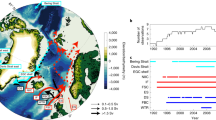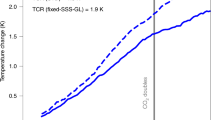Abstract
The efficiency with which the oceans take up heat has a significant influence on the rate of global warming. Warming of the ocean above 700 m over the past few decades has been well documented. However, most of the ocean lies below 700 m. Here we analyse observations of heat uptake into the deep North Atlantic. We find that the extratropical North Atlantic as a whole warmed by 1.45±0.5×1022 J between 1955 and 2005, but Lower North Atlantic Deep Water cooled, most likely as an adjustment from an early twentieth-century warm period. In contrast, the heat content of Upper North Atlantic Deep Water exhibited strong decadal variability. We demonstrate and quantify the importance of density-compensated temperature anomalies for long-term heat uptake into the deep North Atlantic. These anomalies form in the subpolar gyre and propagate equatorwards. High salinity in the subpolar gyre is a key requirement for this mechanism. In the past 50 years, suitable conditions have occurred only twice: first during the 1960s and again during the past decade. We conclude that heat uptake through density-compensated temperature anomalies will contribute to deep ocean heat uptake in the near term. In the longer term, the importance of this mechanism will be determined by competition between the multiple processes that influence subpolar gyre salinity in a changing climate.
This is a preview of subscription content, access via your institution
Access options
Subscribe to this journal
Receive 12 print issues and online access
$259.00 per year
only $21.58 per issue
Buy this article
- Purchase on Springer Link
- Instant access to full article PDF
Prices may be subject to local taxes which are calculated during checkout




Similar content being viewed by others
Change history
22 November 2012
In the version of this Article originally published online, the y axis labels in Fig. 1a–d were incorrect. The labels are now correct in all versions of the Article.
References
Levitus, S., Antonov, J. & Boyer, T. Warming of the world ocean, 1955–2003. Geophys. Res. Lett. 32, L02604 (2005).
Bindoff, N. L. et al. in IPCC Climate Change 2007: The Physical Science Basis (eds Solomon, S. et al.) (Cambridge Univ. Press, 2007).
Domingues, C. M et al. Improved estimates of upper-ocean warming and multi-decadal sea-level rise. Nature 453, 1090–1093 (2008).
Ishii, M. & Kimoto, M. Reevaluation of historical ocean heat content variations with time-varying XBT and MBT depth bias corrections. J. Oceanograph. 65, 287–299 (2009).
Levitus, S. et al. Global ocean heat content 1955–2008 in light of recently revealed instrumentation problems. Geophys. Res. Lett. 36, L07608 (2009).
Purkey, S. & Johnson, G. Warming of global abyssal and deep southern ocean waters between the 1990s and 2000s: Contributions to global heat and level rise budgets. J. Clim. 23, 6336–6351 (2010).
Song, Y. & Colberg, F. Deep ocean warming assessed from altimeters, gravity recovery and climate experiment, in situ measurements, and a non-Boussinesq ocean general circulation model. J. Geophys. Res. 116, C02020 (2011).
Trenberth, K. Global change: The ocean is warming, isn’t it? Nature 465, 304 (2010).
Lozier, M. S. et al. The spatial pattern and mechanisms of heat-content change in the North Atlantic. Science 319, 800–803 (2008).
Ganachaud, A. & Wunsch, C. Large-scale ocean heat and freshwater transports during the World Ocean Circulation Experiment. J. Clim. 16, 696–705 (2003).
Lumpkin, R. & Speer, K. Global ocean meridional overturning. J. Phys. Oceanograph. 37, 2550–2562 (2007).
Talley, L. Freshwater transport estimates and the global overturning circulation: shallow, deep and throughflow components. Prog. Oceanograph. 78, 257–303 (2008).
Dickson, R. et al. Long-term coordinated changes in the convective activity of the North Atlantic. Prog. Oceanograph. 38, 241–295 (1996).
Curry, R. G. & McCartney, M. S. Ocean gyre circulation changes associated with the North Atlantic Oscillation. J. Phys. Oceanograph. 31, 3374–3400 (2001).
Visbeck, M. et al. The ocean’s response to North Atlantic Oscillation variability. in The North Atlantic Oscillation: Climatic Significance and Environmental Impacts Vol. 134 (eds Hurrell, J. W., Kushnir, J. W., Ottersen, Y. & Visbeck, G.) (Geophysical Monograph Series, American Geophysical Union, 2003).
Munk, W. & Wunsch, C. Abyssal recipes II: energetics of tidal and wind mixing. Deep-Sea Res. 45, 1977–2010 (1998).
Bindoff, N. L. & McDougall, T. J. Diagnosing climate change and ocean ventilation using hydrographic data. J. Phys. Oceanograph. 24, 1137–1152 (1994).
Curry, R. G. et al. Oceanic transport of subpolar climate signals to mid-depth subtropical waters. Nature 391, 575–577 (1998).
Yashayaev, I., van Aken, H. M., Holliday, N. P. & Bersch, M. Transformation of the Labrador Sea Water in the subpolar North Atlantic. Geophys. Res. Lett. 34, L22605 (2007).
Yashayaev, I. & Clarke, A. Evolution of North Atlantic water masses inferred from Labrador Sea salinity series. Oceanography 21, 30–45 (2008).
Johnson, G. C. & Wijffels, S. E. Ocean density change contributions to sea level rise. Oceanography 24, 112–121 (2011).
Lozier, M. S. et al. Opposing decadal changes for the North Atlantic meridional overturning circulation. Nature Geosci. 3, 728–734 (2010).
Levitus, S., Antonov, J. I., Boyer, T. P. & Stephens, C. Warming of the world ocean. Science 287, 2225–2229 (2000).
Yashayaev, I. Hydrographic changes in the Labrador Sea, 1960–2005. Prog. Oceanograph. 73, 242–276 (2007).
Sarafanov, A. On the effect of the North Atlantic Oscillation on the temperature and salinity of the subpolar North Atlantic intermediate and deep waters. ICES J. Mar. Sci. 66, 1448–1454 (2009).
Talley, L. D. & McCartney, M. S. Distribution and circulation of Labrador Sea Water. J. Phys. Oceanograph. 12, 1189–1205 (1982).
Fine, R. A. & Molinary, R. L. A continuous deep western boundary Current between Abaco (26.5°N) and Barbados (13°N). Deep-Sea Res. A 35, 1441–1450 (1988).
Sebille, E. v. et al. Propagation pathways of classical Labrador Sea Water from its source region to 26°N. J. Geophys. Res. 116, C12027 (2011).
Leadbetter, S. J., Williams, R. G., McDonagh, E. L & King, B. A. A twenty year reversal in water mass trends in the subtropical North Atlantic. Geophys. Res. Lett. 34, L12608 (2007).
Rhein, M. The Deep Western Boundary Current: Tracers and velocities. Deep-Sea Res. I 41, 263–281 (1994).
Robson, J., Sutton, R., Lohmann, K., Smith, D. & Palmer, M. D. Causes of the rapid warming of the North Atlantic Ocean in the Mid-1990s. J. Clim. 25, 4116–4134 (2012).
Koltermann, K. P. et al. Decadal changes in the thermohaline circulation of the North Atlantic. Deep-Sea Res. II 46, 109–138 (1999).
Bower, A., Lozier, M., Gary, S. & Boning, C. Interior pathways of the North Atlantic meridional overturning circulation. Nature 459, 243–247 (2009).
Drinkwater, K. The regime shift of the 1920s and 1930s in the North Atlantic. Prog. Oceanograph. 68, 134–151 (2006).
Johnson, G., Purkey, S. & Toole, J. Reduced Antarctic meridional overturning circulation reaches the North Atlantic Ocean. Geophys. Res. Lett. 35, L22601 (2008).
Holliday, N. P. et al. Reversal of the 1960s to 1990s freshening trend in the northeast North Atlantic and Nordic Seas. Geophys. Res. Lett. 35, L03614 (2008).
Hughes, S. L., Holliday, N. P. & Beszczynska-Möller, A. ICES Report on Ocean Climate 2009. ICES Cooperative Research Report, 304, 67pp (2010).
Stott, P. A., Sutton, R. T. & Smith, D. M. Detection and attribution of Atlantic salinity changes. Geophys. Res. Lett. 35, L21702 (2008).
Lozier, M. S., Owens, W. B. & Curry, R.G. The climatology of the North Atlantic. Prog. Oceanograph. 36, 1–44 (1995).
Curry, R. & Mauritzen, C. Dilution of the northern North Atlantic Ocean in recent decades. Science 308, 1772–1774 (2005).
Curry, R. HydroBase 2: A database of hydrographic profiles and tools for climatological analysis. Available from http://www.whoi.edu/science/PO/hydrobase. 81 pp (2001).
Hurrell, J. W. & Deser, C. North Atlantic climate variability: The role of the North Atlantic Oscillation. J. Mar. Syst. 79, 231–244 (2010).
Acknowledgements
C.M. and A.M. acknowledge the support of the Norwegian Research Council through iAOOS-Norway (grant number 176096) and the European Union through its 6th Framework Programme Integrated Project DAMOCLES. R.T.S. acknowledges the support of the UK National Centre for Atmospheric Science and the Natural Environment Research Council. We thank J. Gregory and R. Tailleux for valuable comments on the manuscript. We thank R. G. Curry for providing the new Atlantic Ocean analyses, and for valuable assistance with the data analysis at the initial stages of the project.
Author information
Authors and Affiliations
Contributions
C.M. led the study, and performed with A.M. and R.T.S. the analysis and interpretation. A.M. formulated the density space approach and the error analysis, and wrote the Supplementary Information. C.M. and R.T.S. jointly wrote the paper. All authors discussed the results and made comments on the manuscript.
Corresponding author
Ethics declarations
Competing interests
The authors declare no competing financial interests.
Supplementary information
Supplementary Information
Supplementary Information (PDF 6104 kb)
Rights and permissions
About this article
Cite this article
Mauritzen, C., Melsom, A. & Sutton, R. Importance of density-compensated temperature change for deep North Atlantic Ocean heat uptake. Nature Geosci 5, 905–910 (2012). https://doi.org/10.1038/ngeo1639
Received:
Accepted:
Published:
Issue Date:
DOI: https://doi.org/10.1038/ngeo1639
This article is cited by
-
Observational Advances in Estimates of Oceanic Heating
Current Climate Change Reports (2016)



